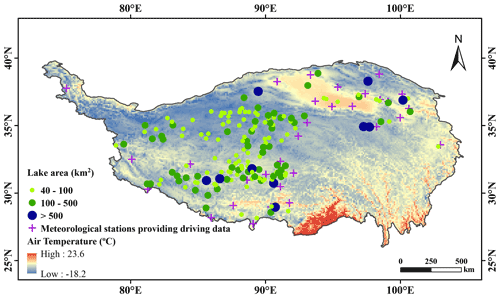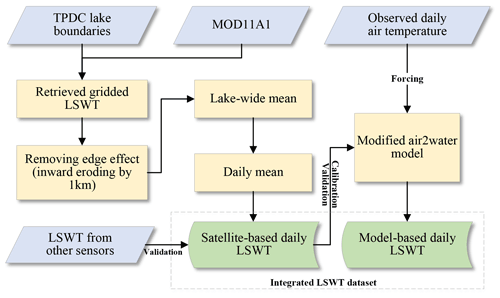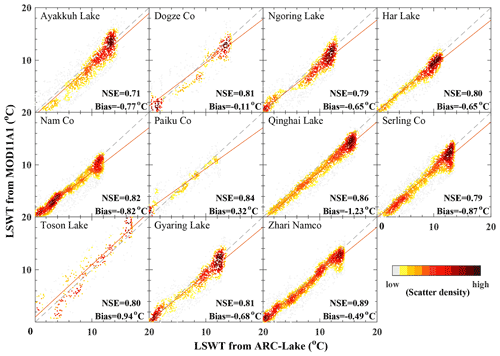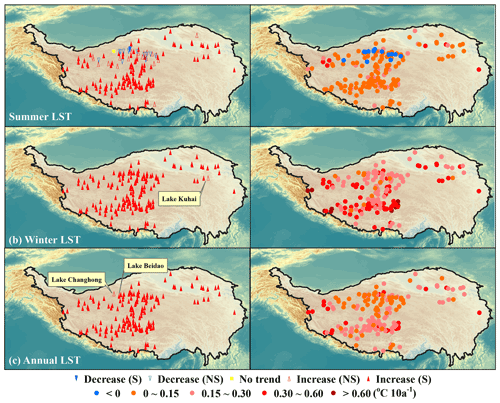the Creative Commons Attribution 4.0 License.
the Creative Commons Attribution 4.0 License.
An integrated dataset of daily lake surface water temperature over the Tibetan Plateau
Linan Guo
Hongxing Zheng
Lanxin Fan
Mengxuan Wen
Junsheng Li
Fangfang Zhang
Liping Zhu
Bing Zhang
Lake surface water temperature (LSWT) is a critical physical property of the aquatic ecosystem and an evident indicator of climate change. By combining the strengths of satellite-based observation and modeling, we have produced an integrated daily LSWT for 160 lakes across the Tibetan Plateau where in situ observation is limited. The MODIS-based lake-wide mean LSWT in the integrated dataset includes the daytime, nighttime, and daily mean for the period 2000–2017. The MODIS-based daily mean LSWT is used to calibrate a simplified physically based model (i.e., modified air2water model), upon which a complete and consistent daily LSWT dataset is reconstructed for the period 1978–2017. The reconstructed LSWT dataset is validated by comparing it with both the satellite-based and in situ observations. The validation shows that the reconstructed LSWT is in good agreement with the observations. According to the reconstructed LSWT dataset, the annual LSWT of lakes in the Tibetan Plateau has increased significantly in the period 1978–2017 with an increase rate ranging from 0.01 to 0.47 ∘C per 10 years. The warming rate is higher in winter than in summer. The integrated dataset is unique for its relatively large temporospatial span (1978–2017) and high temporal resolution. The dataset together with the methods developed can contribute to research in exploring water and heat balance changes and the consequent ecological effects at the Tibetan Plateau. Data from this study are openly available via the Zenodo portal, with DOI https://doi.org/10.5281/zenodo.6637526 (Guo et al., 2022).
- Article
(12561 KB) - Full-text XML
-
Supplement
(973 KB) - BibTeX
- EndNote
Lake surface water temperature (LSWT) is a critical physical property of the aquatic ecosystem and an evident indicator of climate change (Austin and Colman, 2008; Livingstone, 2003; Williamson et al., 2009). A rapid rise in water temperature has been observed in many lakes around the world, which not only reflects the changes in the heat budget of lakes associated with global warming (Bates et al., 2008; Dokulil, 2014) but also has resulted in a succession of changes in physical, chemical, and biological processes within the lake system (Hondzo and Stefan, 1993; Ke and Song, 2014; Naumenko et al., 2006; Ngai et al., 2013; Rahel and Olden, 2008; Schindler, 2001; Woolway and Merchant, 2017; Liu et al., 2021). One of the noticeable consequences of changes in lake water temperature is the considerable change in lake ice phenology (e.g., the freeze-up and break-up dates of lake ice) found at mid- to high-latitude or high-altitude regions around the world during the past few decades (Livingstone, 1997; Takacs et al., 2018; Tian et al., 2015; Prowse et al., 2011).
Lake water temperature records based on in situ measurements of the Tibetan Plateau (TP) are not widely available due to the costs and the geographical restrictions of the region. However, in the TP, where there are more than 1100 alpine lakes with an area larger than 1 km2 and an elevation above 4000 m, most of the lakes have no in situ water temperature records due to the harsh nature for ground observation (Zhang et al., 2014). Satellite-based observation has been showing great potential in providing continuous worldwide records of lake surface temperatures and has developed rapidly in recent decades with increasingly higher temporal and spatial resolutions (Liu et al., 2019; Prats et al., 2018; Schneider and Hook, 2010). At a global scale, currently accessible satellite-based lake surface temperature datasets include those from the ARC-Lake (ATSR Reprocessing for Climate: LSWT and Ice Cover) (Layden et al., 2015) and the GLTC (Global Lake Temperature Collaboration) projects (Sharma et al., 2015). The global datasets are very valuable in stimulating research on inland water bodies (e.g., Moukomla and Blanken, 2017; Piccolroaz et al., 2020; Torbick et al., 2016; Zhang et al., 2014). The datasets, however, have limited use in the TP as they cover only a handful of lakes in that region and are temporally incomplete (Liu et al., 2019). Two other surface water temperature datasets for lakes in the TP have recently been produced by Wan et al. (2017) and Liu et al. (2019) using AVHRR and MODIS, respectively. One of the datasets is based on MODIS land surface temperature products and provides 8 d mean surface temperature of 374 lakes for the period 2001–2015 (Wan et al., 2017), while the other is based on AVHRR and presents daytime LSWT of 97 lakes with an area over 80 km2 for the period 1981–2015 (Liu et al., 2019). Both of the datasets for lakes in the TP, however, have several missing data caused by satellite revisit periods or inconsistency in the time series due to calibration between the successive satellites.
LSWT can alternatively be derived or reconstructed based on well-calibrated modeling (Layden et al., 2016; Prats and Danis, 2019). Process-based numerical models have been used widely to investigate thermodynamics of lakes at local scales (Goudsmit et al., 2002; Kirillin et al., 2017; Launiainen and Cheng, 1998; Peeters et al., 2002; Stepanenko et al., 2016), which usually requires detailed over-lake meteorological data (e.g., wind speed, humidity, cloud cover) as inputs and in situ measurements to calibrate and validate the models (Bruce et al., 2018). For regions with scarce in situ meteorological observations, simple statistical models (Mccombie, 1959; Webb, 1974; Sharma et al., 2008) or simplified physically based models (Piccolroaz et al., 2013) have been developed for use, which may require only air temperature as input. The air2water model proposed by Piccolroaz et al. (2013) is a hybrid model with a strong physical base but simplifies the thermodynamic equations to minimize the input requirement while preserving the robustness of deterministic models. The air2water has been shown to be capable of providing a similar performance, in terms of simulating LSWT, to process-based models and to be an effective tool in reconstructing historical LSWT (Czernecki and Ptak, 2018; Piccolroaz et al., 2020; Schmid and Koster, 2016) and in investigating LSWT responses to climate change for lakes with different morphological characteristics around the world (Piccolroaz et al., 2015; Prats and Danis, 2019; Toffolon et al., 2014). The simplified model is especially competitive and practicable for regions with limited in situ observations to drive and calibrate a more complex process-based model.
We herein combine the strengths of both the remotely sensed and model-based approach in producing an integrated dataset on daily surface water temperature of 160 large lakes across the TP for the period 1978–2017. For the combination, the remotely sensed LSWT is used to calibrate and validate the air2water model, which is then applied to reconstruct a complete and consistent daily LSWT time series for each studied lake and to extend the LSWT dataset to a wider time span. The integrated dataset demonstrates potential in investigating variabilities and changes in LSWT across the TP during the past decades. It could be valuable for assessing the impacts of climate warming on the dynamics of water and heat budget, water quality, and aquatic biota in lakes across the TP.
The TP is located between 26∘00′–39∘47′ N and 73∘19′–104∘47′ E with a mean elevation of over 4500 m and an area about 2.5×106 km2. It is known as the “Asian water tower”, contributing to most major rivers in Asia (Wu and Lei, 2014). The total area of lakes in the plateau is around 45 000 km2, most of which are located at altitudes between 4000 and 5000 m (Yao et al., 2015). Our dataset includes 160 lakes in the TP covering most major lakes with an area over 40 km2 (Fig. 1). All lakes were selected from Records of Lakes in China (Wang and Dou, 1998). The general properties of the studied lakes are listed in the lake_info.csv file of the dataset, which includes the names, locations, and areas of the lakes.
Figure 2 shows the overall framework of our study in integrating the LSWT dataset for the largest lakes across the TP. The MOD11A1 product is the source data for the satellite-based LSWT, while the air temperature data from the meteorological station are the source data used to drive the air2water model. The satellite-based observation is used to calibrate and validate the air2water model. The details of the procedures and methods are described in the following sections.
3.1 Satellite-based observation of lake surface water temperature
The first step of our effort in producing the integrated LSWT dataset is to derive the satellite-based observation from the MOD11 (version 6) provided by NASA's Earth Observing System Data and Information System (EOSDIS, https://earthdata.nasa.gov, last access: 13 July 2022). The MOD11 (Wan, 2013) is the land surface temperature and emissivity products retrieved at 1 km pixels by the generalized split-window algorithm and 6 km grids by the day/night algorithm mainly based on bands 31 (10.78–11.28 µm) and 32 (11.77–12.27 µm) of MODIS (moderate-resolution imaging spectroradiometer) aboard the Terra and Aqua satellite, where Terra overpasses the Equator at around 10:30 (22:30) LT (local time) and Aqua at around 01:30 (13:30) LT. The MOD11 includes products with temporal resolutions of daily, 8 d, and monthly readings. Validation of the MODIS LST product for water surface temperatures against in situ measurements has been conducted and the absolute differences have been reported to be within the range of 0.8–1.9 ∘ (Crosman and Horel, 2009, 2009; Hulley et al., 2011; Reinart and Reinhold, 2008). The bias of MODIS-based LSWT was reported to be around −1.74 ∘C (Song et al., 2016) and −1.4 ∘C (Zhang et al., 2014) over the TP when compared to the limited in situ observations. Different from the 8 d dataset by Wan et al. (2017), herein, we used MOD11A1 (Terra product of Land Surface Temperature/Emissivity Daily L3 Global 1 km) instead of MOD11A2 to produce the daily lake surface temperature dataset. The daily product is used also because it is more suitable to calibrate and validate the air2water model at the same temporal resolution. The MOD11A1 is a tile of daily Level 3 product at 1 km spatial resolution corresponding to the earth locations on the sinusoidal projection.
In our dataset, the satellite observation of LSWT for a specific lake is the lake-wide mean temperature of all 1 km pixels within the lake, which is different to the temperature of the centroid pixels presented by Zhang et al. (2014) and is more consistent with our model settings. In calculating the lake-wide mean surface water temperature, pixels within a lake are identified by the boundaries of the lakes (shapefiles included in the dataset), which are mainly from the National Tibetan Plateau Data Center (TPDC, http://data.tpdc.ac.cn, last access: 13 July 2022) and cross-checked by lake boundary maps from HydroLAKES (http://www.hydrosheds.org/, last access: 13 July 2022) (Messager et al., 2016) and Google Earth. To remove the boundary effects (i.e., where pixels could be a mix of land and water), the boundaries are buffered inward by 1 km. The daily surface water temperature is the mean of daytime and nighttime LST in the MOD11A1. All the data-processing procedures are conducted via Google Earth Engine (GEE). In addition, the MOD11A1 product has noticeable missing values because of cloud effects and the limitation of the algorithm. The gaps in our MODIS LSWT series were marked as “−999”.
3.2 Reconstructing lake surface water temperature
The satellite-based LSWT has been accessible since 2000 and with missing data due to the limitation in the MODIS. To investigate the long-term changes in surface water temperature for lakes in the TP and their responses to climate change, in our integrated datasets, we used a slightly modified air2water model to reconstruct the daily LSWT for the period 1978–2017 based on daily air temperature data from the dataset of daily climate data from Chinese surface stations (V3.0) provided by the China Meteorological Data Service Centre of the National Meteorological Information Centre (http://data.cma.cn/data/cdcdetail/dataCode/SURF_CLI_CHN_MUL_DAY_V3.0.html, last access: 2 July 2021).
The air2water (Piccolroaz et al., 2013) is a semi-physical model designed to simulate lake surface temperature principally based on lake surface heat balance and can be expressed as
where Tw is surface water temperature, Hnet is the net heat flux per unit surface, A is the surface area of the lake, Vs is the volume of water involved in the heat exchange with the atmosphere, and ρ and cp is the density and specific heat capacity of water. The model considers all contributions to the heat balance (Hnet), which are represented as a function of air temperature or are parameterized (Piccolroaz et al., 2013; Piccolroaz, 2016). The original air2water model has simplified the lake heat balance by introducing eight calibratable parameters a1–8 with air temperature as the only required input, which can be expressed as
where, Ta is air temperature and ty is days of a year. is normalized well-mixed depth, where D is the depth of well-mixed surface layer (the epilimnion thickness) and Dr is the maximum thickness. Th is the deep water temperature with the default value being 4 ∘C. The a1–4 in Eq. (2) are the most sensitive parameters determining model performance (Piccolroaz et al., 2013).
The original air2water is limited in simulating the surface temperature of open water, which results in difficulties for applications in lakes with a long duration of ice cover. Therefore, we assume that when the lake is completely covered by ice, the heat exchange between air and water is blocked and the surface energy balance becomes
where Ti is the ice surface temperature and a9–13 have similar physical significance to . To represent the state-shift of the lake between open water and ice-covered parts, two additional parameters a14 and a15 are introduced to determine the states. The lake surface temperature TL can be expressed as
where, is the proportion of ice on the surface of the lake. As in the original model, the model equations were solved numerically using the Crank–Nicolson numerical scheme at the daily time step.
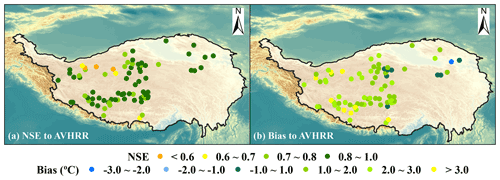
Figure 3Comparison of LSWT from MOD11A1 and AVHRR LSWT for 77 lakes evaluated by NSE (a) and bias (b).
The daily air temperature data used to drive the modified air2water model are from 31 meteorological stations in the TP (Fig. 1). The air temperature above each lake is interpolated from the nearest station and adjusted by a lapse rate of 0.65 ∘C per 100 m (Hu et al., 2014). The model is calibrated against the derived remotely sensed LSWT described in Sect. 3.1 using the particle swarm optimization (PSO) approach (Kennedy and Eberhart, 1995; Piccolroaz, 2016). The objective function of model calibration is the widely adopted Nash–Sutcliffe efficiency coefficient (NSE) (Nash and Sutcliffe, 1970). To ensure the rationality of the calibrated model parameters, a physically consistent a priori range is assigned to each parameter (Piccolroaz, 2016) and Dr is bounded by the average depth of the lake obtained from Records of Lakes in China (Wang and Dou, 1998) and HydroLAKES (Messager et al., 2016). The calibration period is set to be 2000–2012, while 2013–2017 is considered as the validation period. It should be noted that the satellite-derived water temperature is a measurement of instantaneous water temperature at the top of the surface (∼10–20 µm deep), known as “skin temperature”. The skin temperatures can differ from surface water temperature because the thermal structure of the first meters of the water column is not uniform under all conditions. Nevertheless, satellite-derived water temperatures (skin temperatures) are relevant and sufficient for the calibrating and validating hydrodynamic or water quality models of lakes (Andréassian et al., 2012; Prats and Danis, 2019; Prats et al., 2018). For comparison and further validation, the dataset produced by Liu et al. (2019) based on AVHRR was also used.
4.1 MODIS-based LSWT of lakes across the Tibetan Plateau
Three subsets of lake-wide mean surface water temperature are derived and included in our integrated dataset, which are daily daytime LSWT, daily nighttime LSWT, and daily mean LSWT for the period 2000–2017. The LSWT derived from the MOD11A1 is compared with two satellite-based datasets released by other researchers, which were based on AVHRR (Liu et al., 2019) and ARC-Lake (Layden et al., 2015).
Figure 3 shows the comparison between our MOD11A1-based LSWT and the AVHRR-based LSWT (i.e., the TPlake_Temp dataset by Liu et al., 2019) for 77 shared lakes. The TPlake_Temp provides daily LSWT for the period 1981–2015 and for 97 lakes in the TP, which, however, has a different length of data gaps among the lakes. It should be noted that the LSWT from the TPlake_Temp is that of the daytime instead of the daily mean, hence, it is compared against our MODIS-based daytime LSWT instead of mean daily LSWT herein. The LSWT from the two sensors (i.e., AVHRR and MODIS) are largely comparable for the studied lakes, where the NSE and R2 between the LSWT from the two datasets is greater than 0.7 for more than 80 % of the lakes, and the bias ranges from 0.6 to 3.38 ∘C. It is worth mentioning that the MODIS-based LSWT would be better for investigating the long-term changes in lake surface temperature in the TP since the AVHRR-based LSWT from the TPlake_Temp dataset has more missing data and was reported to have abrupt shifts in LSWT due to inconsistent calibration among the successive satellites (Liu et al., 2019).
We further compare the MODIS-based LSWT with that from the ARC-Lake dataset. The ARC-Lake dataset (version 3) included ATSR-2/AATSR-based lake surface temperatures for the period 1995–2012 for 1628 target water bodies distributed globally. Here the daytime and nighttime LSWTs in ARC-Lake are averaged to present daily mean LSWT. Since the ARC-Lake LSWT product is only for open water and a tag temperature during the frozen season with a value of 0 ∘C, in the comparison, only the period in which both MODIS-based and ARC-Lake LSWTs are above 0 ∘C is considered. The LSWTs of 11 studied lakes (location shows in Fig. S1 in the Supplement) are available from the ARC-Lake dataset for the comparison. Besides some outliers where the difference between the two satellite observations is greater than 5 ∘C (around 8 % of the observations in the studied periods), as shown in Fig. 4, the two satellite-based observations of LSWT are mostly comparable to NSE > 0.7 with bias ranging from −1.23 to 0.94 ∘C.
4.2 Reconstructed LSWT by air2water
The reconstructed LSWT by the slightly modified air2water model is compared and validated by the MODIS-based LSWT. As shown in Fig. 5a and b, the spatial pattern of the long-term mean annual LSWT from the reconstructed LSWT is close to that based on MOD11A1 with overall NSE = 0.977 and R2=0.987. For the period 2000–2017, NSE and R2 of most lakes (>90 %) are both over 0.8 with bias ranging at ±0.55 ∘C. The bias for the validation period (2013–2017) is slightly higher than that for the calibration period (see Fig. S2) ranging from −1.7 to 0.9 ∘C. Although there is a tendency showing that NSE is relatively higher for lakes with lower altitude and higher latitude, model performance is found to be weakly related to the altitude and latitude of the lakes (see Fig. S3). The results indicate there is no substantial systematic bias in the reconstructed LSWT. The modified air2water model hence is reliable in reconstructing LSWT for lakes at different altitude or latitude zones. However, it should be noted that uncertainties exist in the reconstructed LSWT due to the uncertainties not only in the calibrated model but also in the air temperature inputted to the model. Summaries of model performance for each month presented in Fig. S4 show that the simulated LSWT has a smaller bias in July and November. As mentioned in Sect. 3.2, the daily air temperature above the lakes is that interpolated from the nearest meteorological stations with elevation adjustment, where the performance of the interpolation would be affected by the density and locations of the stations. Currently, the available meteorological stations are sparsely located in the western TP (Fig. 1), which may result in inherent uncertainties of the reconstructed LSWT for lakes in the western TP. As shown in Fig.5c and 5d, although there is no significant difference in model performance with respect to the locations of the lakes, it is worth exploring further in the future the effects of the interpolation approaches on the simulation of LSWT.
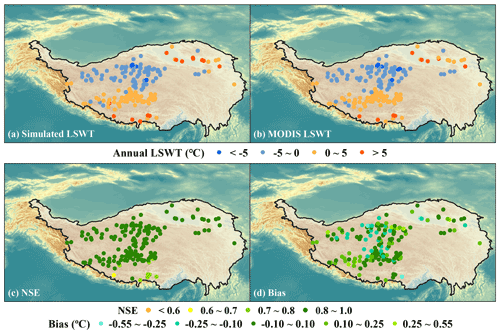
Figure 5Spatial comparison between MOD11A1-based (a) and reconstructed (b) annual mean LSWT and spatial distribution of model performance evaluated by NSE (c) and bias (d).
The in situ observed LSWT is not widely available for lakes in the TP to conduct an overall validation of the modeling results. Nevertheless, we have compared the modeling results against the best publicly available in situ surface water temperature data for lakes in the TP (Table S1 in the Supplement, Figs. S6 and S7), which include sequential observations (Guo et al., 2016; Li et al., 2015; Wang and Hou, 2018) of four lakes (i.e., Ngoring Lake, Serling Co, Dogze Co, Bangong Co) and sporadic observations (simulated LSWT of same day as observation) of 41 lakes (Liu et al., 2015). As shown in Fig. 6, the simulated lake surface temperature is in good agreement temporally with the sequential observations (R2=0.97, 0.92, 0.90, 0.97 for Ngoring Lake, Serling Co, Dogze Co, Bangong Co, respectively) and spatially with the sporadic observations (R2=0.94). Compared with the in situ observations, the RMSE of the simulated temperature is around 2.0 ∘C for the 45 lakes listed in Table S1. It is noted that the bias in the simulation is mainly due to its underestimation for the warmer seasons. Taking Ngoring Lake, for example, for the season when the in situ observed temperature is above 10 ∘C, the RMSE could reach 2.42 ∘C although R2 is greater than 0.70. The bias of the simulated water temperature could be reduced or corrected if the model is calibrated against the observations. However, it is important to note that the simulated water temperature is not completely equivalent to the in situ observations. This is because the simulations represent the lake-wide mean temperature of the skin layer, while the in situ observation used herein is the profile mean temperature for a fixed location in the lake.
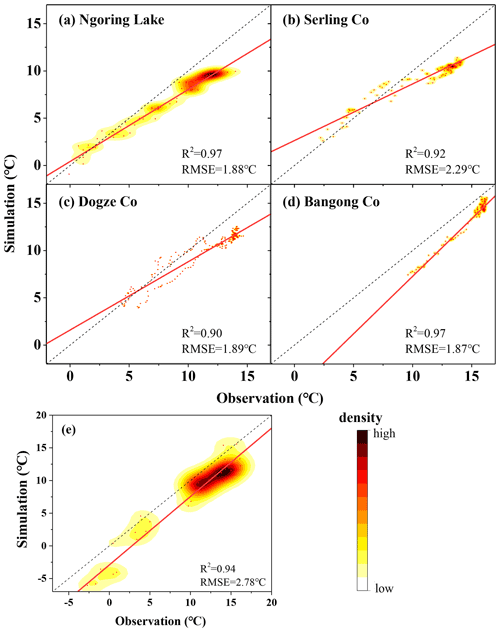
Figure 6Validation of modeling results against in situ observation summarized in Table S1: (a)–(d) is the temporal validation for the four lakes with sequential observation; (e) is the spatial validation for the 41 lakes with sporadic observation. The solid lines are the regression lines. The dashed lines are the 1:1 lines.
4.3 Long-term trends of LSWT in the Tibetan Plateau
On the basis of the reconstructed daily LSWT dataset, the long-term changes of surface water temperatures of lakes across the TP are detected by using the Mann–Kendall trend analysis approach (Kendall, 1949; Mann, 1945). The daily and annual variation of a sample lake is shown in Fig. S5. Figure 7 shows that, for the period 1978–2017, the annual LSWT of most lakes (except for Lake Beidao and Lake Changhong) increase significantly at rates ranging from 0.01 to 0.47 ∘C per 10 years, which is consistent with but comparably smaller than that of the increasing rate in air temperature (0.26–0.87 ∘C per 10 years) indicating the contributions of heat storage capacity of the lakes. Lakes in the southern TP are generally found to have higher warming rates than those in the northern TP. The increase in LSWT is more evident in the winter season (December to February) than in the summer season (June to August). Except for Lake Kuhai, the LSWTs of all the other lakes increase significantly at a rate ranging from 0.06 and 0.96 ∘C per 10 years. In summer, while most of the lakes (125 out of 160) show a significant increase in LSWT, the LSWTs of 13 lakes located in the northern part of the TP decrease nonsignificantly. It should be noted that the warming and cooling trends could inherit uncertainties from the modeling, which needs further validation when more in situ observations become available.
The source code of the modified model is freely available at https://doi.org/10.5281/zenodo.6831947 (Guo and Zheng, 2022) or https://github.com/Siyu1993/ModifiedModel.git (last access: 13 July 2022).
Table 1 gives the details of the data included in our integrated dataset. In the dataset, the properties of the lakes (including name, latitude, longitude, altitude) are listed in the lake_info.csv file. The boundaries of the lakes are provided in the ESRI shapefile format. The satellite-based observations of the LSWT are given as the MOD11A1_DT and MOD11A1_NT for the daytime and nighttime lake-wide mean lake surface water temperature, while the MOD11A1_DM is the mean of these parameters representing the daily mean surface water temperature. The time span of the MODIS-based LSWT is for the period 2000–2017. The Air2Water_DM is the reconstructed daily LSWT based on the modified air2water model for the period 1978–2017. Time series plots for each lake are also included in the dataset for readers to have a quick view. The dataset is archived and openly accessible via the Zenodo portal: https://doi.org/10.5281/zenodo.6637526 (Guo et al., 2022).
An integrated daily LSWT dataset has been produced for 160 lakes across the TP by combining the strengths of satellite-based observations and model-based approaches. The satellite-based lake-wide mean LSWT is derived from MOD11A1 via Google Earth Engine, which includes data for the daytime, nighttime, and daily mean for the period 2000–2017. The dataset is found to be comparable to other satellite-based LSWT products (e.g., LSWT from AVHRR and ARC-Lake) but unique due to its temporospatial span and resolution. The satellite-based LSWT enables the calibration and validation of a simplified heat balance model (i.e., air2water) in regions with scarce ground-based observations (like the TP).
The modified air2water model is found to be successful in reconstructing the daily LSWT of lakes across the TP by extending the LSWT time series to the period 1978–2017 and filling the time gaps in the satellite-based LSWT albeit with uncertainties from model inputs and model parameterization. The completeness and consistency of the reconstructed LSWT dataset therefore mean it is reliable and valuable for investigating the long-term variation and changes of LSWT in the TP. According to the reconstructed LSWT dataset, the annual LSWT is significantly increased during the period 1978–2017 with an increase rate ranging from 0.01 to 0.47 ∘C per 10 years. The warming trend of the lakes is more evident in winter than in summer. The integrated dataset together with the methods introduced herein can contribute to research in exploring water and heat balance changes in the TP and the consequent ecological effects.
The supplement related to this article is available online at: https://doi.org/10.5194/essd-14-3411-2022-supplement.
YW, HZ, BZ, and LG conceived the research. LG, YW, and HZ developed the approaches and datasets. LG, MW, and LF collected basic data of the lakes. JL and SW checked the results. LG, HZ, and YW wrote the original draft. BZ and LZ revised the draft.
The contact author has declared that none of the authors has any competing interests.
Publisher's note: Copernicus Publications remains neutral with regard to jurisdictional claims in published maps and institutional affiliations.
We gratefully acknowledge the Climate Data Center, National Meteorological Information Center, China Meteorological Administration, for providing the long-term meteorological data of the 31 stations.
This research has been supported by the Second Tibetan Plateau Scientific Expedition and Research Program (STEP) (grant no. 2019QZKK0202) and National Natural Science Foundation of China (grant no. 41671203).
This paper was edited by Kirsten Elger and reviewed by two anonymous referees.
Andréassian, V., Le Moine, N., Perrin, C., Ramos, M.-H., Oudin, L., Mathevet, T., Lerat, J., and Berthet, L.: All that glitters is not gold: the case of calibrating hydrological models, Hydrol. Process., 26, 2206–2210, https://doi.org/10.1002/hyp.9264, 2012.
Austin, J. and Colman, S.: A century of temperature variability in Lake Superior, Limnol. Oceanogr., 53, 2724–2730, https://doi.org/10.4319/lo.2008.53.6.2724, 2008.
Bates, B., Kundzewicz, Z. W., Wu, S., and Palutikof, J.: Climate Change and Water: Technical Paper VI, Environ. Policy Collect., 128, 343–355, https://doi.org/10.1061/(ASCE)0733-9496(2002)128:5(343), 2008.
Bruce, L., Frassl, M., and Arhonditsis, G. B.: A multi-lake comparative analysis of the General Lake Model (GLM): Stress-testing across a global observatory network, Environ. Model. Softw., 102, 274–291, https://doi.org/10.1016/j.envsoft.2017.11.016, 2018.
Crosman, E. T. and Horel, J. D.: MODIS-derived surface temperature of the Great Salt Lake, Remote Sens. Environ., 113, 73–81, https://doi.org/10.1016/j.rse.2008.08.013, 2009.
Czernecki, B. and Ptak, M.: The impact of global warming on lake surface water temperature in Poland – the application of empirical-statistical downscaling, 1971–2100, J. Limnol., 77, 330–348, https://doi.org/10.4081/jlimnol.2018.1707, 2018.
Dokulil, M. T.: Predicting summer surface water temperatures for large Austrian lakes in 2050 under climate change scenarios, Hydrobiologia, 731, 19–29, https://doi.org/10.1007/s10750-013-1550-5, 2014.
Goudsmit, G. H., Burchard, H., Peeters, F., and Wuest, A.: Application of k–ϵ turbulence models to enclosed basins: The role of internal seiches, J. Geophys. Res.-Oceans, 107, 3230, https://doi.org/10.1029/2001jc000954, 2002.
Guo, L., and Zheng, H.: Modified_air2water_Model: v1.0.1, Zenodo [code], https://doi.org/10.5281/zenodo.6831947, 2022.
Guo, L., Wu, Y., Zheng, H., Zhang, B., and Wen., M.: An integrated dataset of daily lake surface temperature over Tibetan Plateau, Zenodo [data set], https://doi.org/10.5281/zenodo.6637526, 2022.
Guo, Y. H., Zhang, Y. S., Ma, N., Song, H. T., and Gao, H. F.: Quantifying Surface Energy Fluxes and Evaporation over a Significant Expanding Endorheic Lake in the Central Tibetan Plateau, J. Meteorol. Soc. Jpn., 94, 453–465, https://doi.org/10.2151/jmsj.2016-023, 2016.
Hondzo, M. and Stefan, H. G.: Regional Water Temperature Characteristics of Lakes Subjected to Climate-Change, Climatic Change, 24, 187–211, https://doi.org/10.1007/bf01091829, 1993.
Hu, Q., Jiang, D., and Fan, G.: Evaluation of CMIP5 models over the Qinghai-Tibetan Plateau, Chin. J. Atmos. Sci., 38, 924–938, https://doi.org/10.3878/j.issn.1006-9895, 2014.
Hulley, G. C., Hook, S. J., and Schneider, P.: Optimized split-window coefficients for deriving surface temperatures from inland water bodies, Remote Sens. Environ., 115, 3758–3769, https://doi.org/10.1016/j.rse.2011.09.014, 2011.
Ke, L. H., and Song, C. Q.: Remotely sensed surface temperature variation of an inland saline lake over the central Qinghai-Tibet Plateau, ISPRS J. Photogram. Remote Sens., 98, 157–167, https://doi.org/10.1016/j.isprsjprs.2014.09.007, 2014.
Kendall, M. G.: Rank correlation methods, Econ. J., 59, 575–577, https://doi.org/10.2307/2226580, 1949.
Kennedy, J. and Eberhart, R.: Particle swarm optimization, in: Proceedings of ICNN'95-International Conference on Neural Networks, 27 November–1 December 1995, Perth, WA, Australia, 1942–1948, https://doi.org/10.1109/ICNN.1995.488968, 1995.
Kirillin, G., Wen, L. J., and Shatwell, T.: Seasonal thermal regime and climatic trends in lakes of the Tibetan highlands, Hydrol. Earth Syst. Sci., 21, 1895–1909, https://doi.org/10.5194/hess-21-1895-2017, 2017.
Launiainen, J. and Cheng, B.: Modelling of ice thermodynamics in natural water bodies, Cold Reg. Sci. Tech., 27, 153–178, https://doi.org/10.1016/s0165-232x(98)00009-3, 1998.
Layden, A., Merchant, C., and MacCallum, S.: Global climatology of surface water temperatures of large lakes by remote sensing, Int. J. Climatol., 35, 4464–4479, https://doi.org/10.1002/joc.4299, 2015.
Layden, A., MacCallum, S. N., and Merchant, C. J.: Determining lake surface water temperatures worldwide using a tuned one-dimensional lake model (FLake, v1), Geosci. Model Dev., 9, 2167–2189, https://doi.org/10.5194/gmd-9-2167-2016, 2016.
Li, Z. G., Lyu, S. H., Ao, Y. H., Wen, L. J., Zhao, L., and Wang, S. Y.: Long-term energy flux and radiation balance observations over Lake Ngoring, Tibetan Plateau, Atmos. Res., 155, 13–25, https://doi.org/10.1016/j.atmosres.2014.11.019, 2015.
Liu, B. J., Wan, W., Xie, H. J., Li, H., Zhu, S. Y., Zhang, G. Q., Wen, L. J., and Hong, Y.: A long-term dataset of lake surface water temperature over the Tibetan Plateau derived from AVHRR 1981–2015, Scient. Data, 6, 48, https://doi.org/10.1038/s41597-019-0040-7, 2019.
Liu, C., Zhu, L., Wang, J., Ju, J., Ma, Q., Qiao, B., Wang, Y., Xu, T., Chen, H., Kou, Q., Zhang, R., and Kai, J.: In-situ water quality investigation of the lakes on the tibetan plateau, Sci. Bull., 66, 1727–1730, https://doi.org/10.1016/j.scib.2021.04.024, 2021.
Livingstone, D. M.: Break-up dates of Alpine lakes as proxy data for local and regional mean surface air temperatures, Climatic Change, 37, 407–439, https://doi.org/10.1023/a:1005371925924, 1997.
Livingstone, D. M.: Impact of Secular Climate Change on the Thermal Structure of a Large Temperate Central European Lake, Climatic Change, 57, 205–225, https://doi.org/10.1023/A:1022119503144, 2003.
Mann, H. B.: Nonparametric Tests Against Trend, Econometrica, 13, 245–259, https://doi.org/10.2307/1907187, 1945.
Mccombie, A. M.: Some Relations Between Air Temperatures and the Surface Water Temperatures of Lakes, Limnol. Oceanogr., 4, 252–258, https://doi.org/10.4319/lo.1959.4.3.0252, 1959.
Messager, M. L., Lehner, B., Grill, G., Nedeva, I., and Schmitt, O.: Estimating the volume and age of water stored in global lakes using a geo-statistical approach, Nat. Commun., 7, 11, https://doi.org/10.1038/ncomms13603, 2016.
Moukomla, S. and Blanken, P. D.: Estimating the Great Lakes net radiation using satellite remote sensing and MERRA reanalysis, Int. J. Digit. Earth, 10, 764–784, https://doi.org/10.1080/17538947.2016.1252432, 2017.
Nash, J. E. and Sutcliffe, J. V.: River flow forecasting through conceptual models part I – A discussion of principles – ScienceDirect, J. Hydrol., 10, 282–290, https://doi.org/10.1016/0022-1694(70)90255-6, 1970.
Naumenko, M. A., Guzivaty, V. V., and Karetnikov, S. G.: Climatic trends of the water surface temperature in Lake Ladoga during ice-free periods, Dokl. Earth Sci., 409, 750–753, https://doi.org/10.1134/s1028334x06050163, 2006.
Ngai, K. L. C., Shuter, B. J., Jackson, D. A., and Chandra, S.: Projecting impacts of climate change on surface water temperatures of a large subalpine lake: Lake Tahoe, USA, Climatic Change, 118, 841–855, https://doi.org/10.1007/s10584-013-0695-6, 2013.
Peeters, F., Livingstone, D. M., Goudsmit, G. H., Kipfer, R., and Forster, R.: Modeling 50 years of historical temperature profiles in a large central European lake, Limnol. Oceanogr., 47, 186–197, https://doi.org/10.4319/lo.2002.47.1.0186, 2002.
Piccolroaz, S.: Prediction of lake surface temperature using the air2water model: guidelines, challenges, and future perspectives, Adv. Oceanogr. Limnol., 7, 36–50, https://doi.org/10.4081/aiol.2016.5791, 2016.
Piccolroaz, S., Toffolon, M., and Majone, B.: A simple lumped model to convert air temperature into surface water temperature in lakes, Hydrol. Earth Syst. Sci., 17, 3323–3338, https://doi.org/10.5194/hess-17-3323-2013, 2013.
Piccolroaz, S., Toffolon, M., and Majone, B.: The role of stratification on lakes' thermal response: The case of Lake Superior, Water Resour. Res., 51, 7878–7894, https://doi.org/10.1002/2014wr016555, 2015.
Piccolroaz, S., Woolway, R. I., and Merchant, C. J.: Global reconstruction of twentieth century lake surface water temperature reveals different warming trends depending on the climatic zone, Climatic Change, 160, 427–442, https://doi.org/10.1007/s10584-020-02663-z, 2020.
Prats, J., and Danis, P. A.: An epilimnion and hypolimnion temperature model based on air temperature and lake characteristics, Knowl. Manage. Aquat. Ecosyst., 8, 420, https://doi.org/10.1051/kmae/2019001, 2019.
Prats, J., Reynaud, N., Rebiere, D., Peroux, T., Tormos, T., and Danis, P. A.: LakeSST: Lake Skin Surface Temperature in French inland water bodies for 1999–2016 from Landsat archives, Earth Syst. Sci. Data, 10, 727–743, https://doi.org/10.5194/essd-10-727-2018, 2018.
Prowse, T., Alfredsen, K., Beltaos, S., Bonsal, B. R., Bowden, W. B., Duguay, C. R., Korhola, A., Mcnamara, J., Vincent, W. F., and Vuglinsky, V.: Effects of Changes in Arctic Lake and River Ice, Ambio, 40, 63–74, https://doi.org/10.1007/s13280-011-0217-6, 2011.
Rahel, F. J. and Olden, J. D.: Assessing the effects of climate change on aquatic invasive species, Conserv. Biol., 22, 521–533, https://doi.org/10.1111/j.1523-1739.2008.00950.x, 2008.
Reinart, A. and Reinhold, M.: Mapping surface temperature in large lakes with MODIS data, Remote Sens. Environ., 112, 603–611, https://doi.org/10.1016/j.rse.2007.05.015, 2008.
Schindler, D. W.: The cumulative effects of climate warming and other human stresses on Canadian freshwaters in the new millennium, Can. J. Fish. Aquat. Sci., 58, 18–29, https://doi.org/10.1139/cjfas-58-1-18, 2001.
Schmid, M. and Koster, O.: Excess warming of a Central European lake driven by solar brightening, Water Resour. Res., 52, 8103–8116, https://doi.org/10.1002/2016wr018651, 2016.
Schneider, P. and Hook, S. J.: Space observations of inland water bodies show rapid surface warming since 1985, Geophys. Res. Lett., 37, L22405, https://doi.org/10.1029/2010gl045059, 2010.
Sharma, S., Walker, S. C., and Jackson, D. A.: Empirical modelling of lake water-temperature relationships: a comparison of approaches, Freshwater Biol., 53, 897–911, https://doi.org/10.1111/j.1365-2427.2008.01943.x, 2008.
Sharma, S., Gray, D. K., Read, J. S., O'Reilly, C. M., Schneider, P., Qudrat, A., Gries, C., Stefanoff, S., Hampton, S. E., Hook, S., Lenters, J. D., Livingstone, D. M., McIntyre, P. B., Adrian, R., Allan, M. G., Anneville, O., Arvola, L., Austin, J., Bailey, J., Baron, J. S., Brookes, J., Chen, Y., Daly, R., Dokulil, M., Dong, B., Ewing, K., de Eyto, E., Hamilton, D., Havens, K., Haydon, S., Hetzenauer, H., Heneberry, J., Hetherington, A. L., Higgins, S. N., Hixson, E., Izmest'eva, L. R., Jones, B. M., Kangur, K., Kasprzak, P., Koster, O., Kraemer, B. M., Kumagai, M., Kuusisto, E., Leshkevich, G., May, L., MacIntyre, S., Mueller-Navarra, D., Naumenko, M., Noges, P., Noges, T., Niederhauser, P., North, R. P., Paterson, A. M., Plisnier, P.-D., Rigosi, A., Rimmer, A., Rogora, M., Rudstam, L., Rusak, J. A., Salmaso, N., Samal, N. R., Schindler, D. E., Schladow, G., Schmidt, S. R., Schultz, T., Silow, E. A., Straile, D., Teubner, K., Verburg, P., Voutilainen, A., Watkinson, A., Weyhenmeyer, G. A., Williamson, C. E., and Woo, K. H.: A global database of lake surface temperatures collected by in situ and satellite methods from 1985–2009, Sci. Data, 2, 150008, https://doi.org/10.1038/sdata.2015.8, 2015.
Song, K., Wang, M., Du, J., Yuan, Y., Ma, J., Wang, M., and Mu, G.: Spatiotemporal Variations of Lake Surface Temperature across the Tibetan Plateau Using MODIS LST Product, Remote Sens., 8, 854, https://doi.org/10.3390/rs8100854, 2016.
Stepanenko, V., Mammarella, I., Ojala, A., Miettinen, H., Lykosov, V., and Vesala, T.: LAKE 2.0: a model for temperature, methane, carbon dioxide and oxygen dynamics in lakes, Geosci. Model Dev., 9, 1977–2006, https://doi.org/10.5194/gmd-9-1977-2016, 2016.
Takacs, K., Kern, Z., and Pasztor, L.: Long-term ice phenology records from eastern-central Europe, Earth Syst. Sci. Data, 10, 391–404, https://doi.org/10.5194/essd-10-391-2018, 2018.
Tian, B. S., Li, Z., Engram, M. J., Niu, F. J., Tang, P. P., Zou, P. F., and Xu, J.: Characterizing C-band backscattering from thermokarst lake ice on the Qinghai-Tibet Plateau, ISPRS J. Photogram. Remote Sens., 104, 63–76, https://doi.org/10.1016/j.isprsjprs.2015.02.014, 2015.
Toffolon, M., Piccolroaz, S., Majone, B., Soja, A. M., Peeters, F., Schmid, M., and Wuest, A.: Prediction of surface temperature in lakes with different morphology using air temperature, Limnol. Oceanogr., 59, 2185–2202, https://doi.org/10.4319/lo.2014.59.6.2185, 2014.
Torbick, N., Ziniti, B., Wu, S., and Linder, E.: Spatiotemporal Lake Skin Summer Temperature Trends in the Northeast United States, Earth Interact., 20, 1–21, https://doi.org/10.1175/ei-d-16-0015.1, 2016.
Wan, W., Li, H., Xie, H., Hong, Y., Long, D., Zhao, L., Han, Z., Cui, Y., Liu, B., and Wang, C.: A comprehensive data set of lake surface water temperature over the Tibetan Plateau derived from MODIS LST products 2001–2015, Scient. Data, 4, 170095, https://doi.org/10.1038/sdata.2017.95, 2017.
Wan, Z.: Collection-6 MODIS land surface temperature products users' guide, ICESS, University of California, Santa Barbara, https://lpdaac.usgs.gov/documents/118/MOD11_User_Guide_V6.pdf (last access: 13 July 2022), 2013.
Wang, M. and Hou, J.: Monitoring data on lake water temperature in Bangong Co and Dagze Co (2012–2013), National Tibetan Plateau Data Center, https://doi.org/10.11888/Hydrology.tpe.249431.db, 2018.
Wang, S. M. and Dou, H. S.: Records of lakes in China, Science Press, Beijing, 342–483, ISBN 7-03-006706-1, 1998.
Webb, M. S.: Surface temperatures of Lake Erie, Water Resour. Res., 10, 199–210, https://doi.org/10.1029/WR010i002p00199, 1974.
Williamson, C. E., Saros, J. E., and Schindler, D. W.: Climate Change Sentinels of Change, Science, 323, 887–888, https://doi.org/10.1126/science.1169443, 2009.
Woolway, R. I. and Merchant, C. J.: Amplified surface temperature response of cold, deep lakes to inter-annual air temperature variability, Sci. Rep., 7, 4130, https://doi.org/10.1038/s41598-017-04058-0, 2017.
Wu, Y. and Lei, L.: Water level variation of Inland lakes on the southeasten of Tibetan Plateau in 1972–2012, Acta Geogr. Sin., 69, 993–1001, https://doi.org/10.11821/dlxb201407011, 2014.
Yao, T., Wu, F., Ding, L., Sun, J., Zhu, L., Piao, S., Deng, T., Ni, X., Zheng, H., and Ouyang, H.: Multispherical interactions and their effects on the Tibetan Plateau's earth system: a review of the recent researches, Natl. Sci. Rev., 2, 468–488, https://doi.org/10.1093/nsr/nwv070, 2015.
Zhang, G. Q., Yao, T. D., Xie, H. J., Qin, J., Ye, Q. H., Dai, Y. F., and Guo, R. F.: Estimating surface temperature changes of lakes in the Tibetan Plateau using MODIS LST data, J. Geophys. Res.-Atmos., 119, 8552–8567, https://doi.org/10.1002/2014jd021615, 2014.





